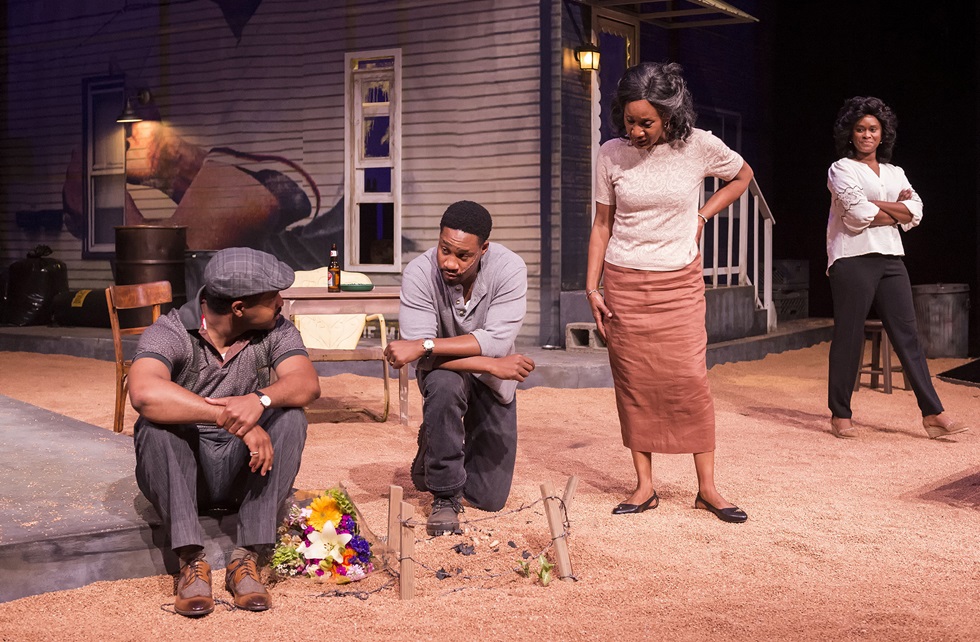
PASADENA, Calif –– A Noise Within continues its commitment to August Wilson’s “American Century Cycle,” ten plays representing aspects of the Black experience in each decade of the 20th century, with a new production of King Hedley II. Regular readers of this news site may recall other plays in the series, such as Radio Golf, Jitney, Two Trains Running, and Fences, which was filmed with Denzel Washington and Viola Davis. The two-time Pulitzer Prize-winning playwright, who died all too young at the age of 60 in 2005, was honored in 2021 with a U.S. “forever” stamp in the “Black Heritage” series.
Gregg T. Daniel, who previously directed the company’s productions of Wilson’s Gem of the Ocean, Seven Guitars, and Radio Golf, returns to direct the ninth play of the cycle that explores themes of the Reagan-era 1980s.

King Hedley II is a tautly conceived, densely plotted play with six characters. Their stories go back dozens of years with intertwining relationships, themes, and background incidents. Although on the surface it may appear as though Wilson’s cast are dominated by hustlers and ne’er-do-wells, it’s the two women, above all, who bear the pain of the community on their strong backs with their perseverance, humanity, higher aims for themselves and their families, and a more realistic sense of dignity and honor. The men, by contrast, are rageful, quick to anger, all too eager to settle scores with violence, and addicted to a heightened, ego-driven posture of honor and oneupmanship which only worsens their troubles. The title character, for example, takes extreme umbrage as another man calls him “Champ” rather than “King.”
If you scratch below the surface, though, which one can always count on August Wilson to do, his characters are practically case studies in the manufacture of thwarted personalities by a cruel, racist system that goes back to 1619 in this country. Black men are held back in school—labeled “unruly” for asking to use the bathroom—sent to prison for crimes whites might not be, or might not serve as much time for, and rarely given an equal opportunity to compete for respectable work. Under slavery, King observes, he would have been worth $1200. Now he’s just worth $3.35 an hour—as good a synopsis of wage theory as you might find in the theater.
Much is made in this play, for example, of construction contracts up for bid: When a Black man submits the lowest bid, the contract is not awarded to him on the theory that he obviously doesn’t know what he’s getting into and will not successfully complete the job. Even that small profit margin is denied to the Black man. It’s the establishment, not the Black men, that refuses to play by the rules. In another instance in the play, King relates of presenting a receipt for some photos, being told it’s worthless, and almost getting arrested for it. His conclusion: “I don’t count…. Every time I try to do something, they block you at every turn.”

King Hedley (Aaron Jennings), visibly (and symbolically) scarred after a violent incident years before, comes home after seven years in prison, eager to rebuild his life. Emblematic of his hopes and dreams are the seeds he plants in a small, sandy plot not more than a couple of feet square that would seem to defy growth, and the fact that his 35-year-old wife Tonya (Kacie Rogers) is pregnant with his much-wanted child, whom King conceives as “Hedley III.” (Tonya is seen studying for a degree, but her 17-year-old daughter, unseen in the play, goes counter to the noble, stable woman trope, as she is herself now a mother with no idea either of who the father is nor what to do with her life.) King imagines a halo around his head—that no one else sees, of course—that suggests his belief in being cut out to do great things. But though he tries to better himself, he soon gets caught up with his best friend Mister (Christian Henley) in the shady business of selling stolen appliances to his neighbors.
King’s mother Ruby (Veralyn Jones) is a former Big Band singer now fallen on hard times, awaiting the opening of a senior public housing complex where she’d like to move, as soon as the city purchases her home for redevelopment. Another ex-con makes his appearance, Ruby’s old lover Elmore (Ben Cain), 66, a born hustler and bettor who betrayed Ruby once before and now attempts to woo his way back into her favor.
And in a star turn as the mentally unstable Stool Pigeon, Gerald Rivers returns to the stage spouting visionary biblical and African folktales of gods meting out severe, perfect justice. We encounter him just as Aunt Ester has died, the reputedly 366-year-old griot and soothsayer of the community who has connected the African-American residents of Pittsburgh’s Hill District to their spiritual roots. He buries Ester’s old black cat in King’s garden, believing that after a week, if watered with sacrificial blood, the cat will return to life. His fatalism may echo Wilson’s own philosophy: The beginning and the end of the story, the seer tells us, have already been written, and now all that’s left is to play it out.
The playwright started his literary career as a poet, and he famously studs his plays with gorgeously lyrical soliloquies that eloquently encapsulate each of his characters’ frame of mind. “Wilson is our American Shakespeare,” say A Noise Within co-artistic directors Geoff Elliott and Julia Rodriguez-Elliott, “and his language comes alive in the mouths of fine actors in a similar way. This play is a tragedy, but there’s so much humor in it. That is part of the humanity Wilson brings to his work.” In this production, there’s nary an actor who falls short in delivering the playwright’s goods. It all plays out, movingly acted at the highest level of theater.
In some ways the story Wilson unspools in King Hedley II could, with minimal verbal adjustments. have been set at almost any time—the beginning of the 20th century, the ’30s, the ’50s. In several of the plays set in the post-war period, the theme of urban renewal (otherwise known as Black removal) is the preeminent condition for the action. It’s present but seems to be less the commanding feature here. One has to think hard to understand what it was about the 1980s (it’s set precisely in 1985) that informs the play. Perhaps it’s the get-rich-quick mentality of the Reagan years; perhaps the immorality, and indeed criminality, of his administration (Iran-Contra, anyone?), the favoritism, the open racism and anti-labor stance of Reagan’s sentimental appeal to the values of some lost American ideal, the leg-up his regime gave to the wealthy. All of which, naturally, left people of color behind in the mad rush to the bank—leaving those at the bottom of the ladder to struggle for their existence in any way possible, including the various unregulated “free market” hustles we witness here.
Another indication, at least at first glance, that the play might have been set in almost any decade is that its cast of struggling lowlifes and spottily employed lumpen characters show no influence of the Black Power movements on the previous two or three decades, in fact, not even of the civil rights battles and achievements of the 1960s and beyond. Almost illogically, the drug culture is absent here, though firearms—and a machete—are some serious plot elements. The spirit of the Panthers and other self-help community efforts is out of sight. Given the halting—and reversible—progress in the decades since, starting with the Reagan retreat, maybe it’s the sage Wilson telling us that progress is not so easily won and certainly not to be counted on as permanent. And where these denizens of the Hill will garner allies is a question unexplored.
Brilliant an observer as August Wilson was, we may have to admit that his sharp vision was more a cultural and artistic perception that was not necessarily revolutionary in a political sense: He may have eschewed any hint of agitprop in the interest of getting widely recognized and produced.
Yet by calling our attention to the unrelenting oppression over the last 400 years-plus, he has done his work. It’s now up to us to act on it.
The creative team includes scenic designer Efren Delgadillo Jr; lighting designer Brandon Baruch; sound designer Jeff Gardner; costume designer Mylette Nora; wig and makeup designer Shelia Dorn; properties designer Stephen Taylor; and dramaturg Dr. Miranda Johnson-Haddad. The production stage manager is Taylor Anne Cullen, with Arielle Hightower assisting. The producing sponsors are Dick and Sally Roberts.
Performances of King Hedley II take place through April 28 on Thurs. at 7:30 p.m., Fri. at 8 p.m., Sat. at 2 and 8 p.m., and Sun. at 2 p.m. (with no evening performance on Thurs. the 18th or Sat., April 27). Post-performance conversations take place every Fri. and on Sun., April 14. A Noise Within is located at 3352 E. Foothill Blvd., Pasadena, CA 91107. King Hedley II is recommended for ages 14 and up. For more information and to purchase tickets, call (626) 356–3100 or go to www.anoisewithin.org.
We hope you appreciated this article. At People’s World, we believe news and information should be free and accessible to all, but we need your help. Our journalism is free of corporate influence and paywalls because we are totally reader-supported. Only you, our readers and supporters, make this possible. If you enjoy reading People’s World and the stories we bring you, please support our work by donating or becoming a monthly sustainer today. Thank you!












Comments